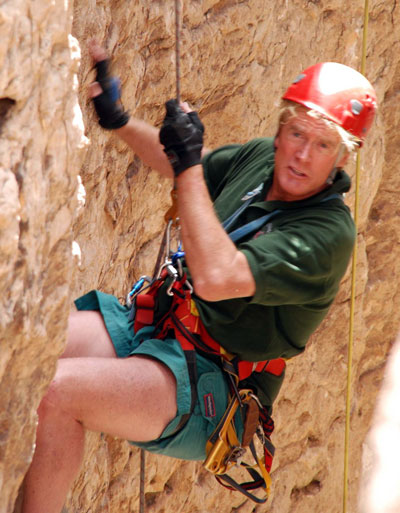A familiar face to millions of Americans, Dr. Bob Arnot is an award-winning medical correspondent, sports enthusiast, best-selling author, and physician.
Throughout his busy career, Dr. Arnot remained a passionate athlete, competing in marathons, bike races, ski competitions, and big wave surfing.
Eventually, the wear and tear took its toll. At age 60, the medical journalist discovered that both of his hips were, in his words, “completely shot.” For years, he tried to disguise the pain.
“I couldn’t really walk more than a couple of blocks without severe pain,” Dr. Arnot recalls. “When my youngest son was 3 years old, I couldn’t bend down to pick him up or play with him on the floor. I had unwittingly given up a large part of life.”
Follow-up tests confirmed his suspicions.
“The x-rays showed pure bone on bone,” Dr. Arnot told the Post. “One prominent surgeon said, ‘Your hips are too far gone, so you’ll have to have a total hip replacement.’ ”
But a total hip replacement at his relatively young age and level of conditioning would place limitations on his
activities. After hip replacement surgery, patients are advised to avoid certain activities, including jogging and high-impact sports for the rest of their lives, according to the American Academy of Orthopaedic Surgeons.
“With a total hip replacement, I would never consider running again,” the avid sports enthusiast says. “But I feel young, like to be active, and wanted to run and ski again without limitations.”
Dr. Arnot wasn’t ready to make that sacrifice without exploring alternatives.
Faced with a difficult decision, Dr. Arnot applied his journalistic skills and met with leaders in the field, from the inventors of the Birmingham hip resurfacing operation in England to top orthopedic experts in New York, Boston, and Los Angeles. By the time he reached a decision, he knew the best option for him.
“The more I investigated the hip resurfacing procedure, the clearer it became that I would have a perfect biomechanical result,” the television host explained. “I would be able to run, ski, and do virtually anything I wanted to do.”
In April 2008, Dr. Arnot underwent the hip resurfacing procedure on both hips.
“The operation was the closest thing I could imagine to one of medicine’s modern miracles,” he says. “Within four days, I was walking a mile. Within 10 days, I was walking three miles, even though on crutches. I couldn’t believe it was possible. Within three weeks, I was back on a stair machine, and at one month on a bike. This past summer, I did a 100-mile bike ride or race almost every weekend against people one-third my age and still came out in the top. This winter, I’m back into ski racing.”
He also resumed routine activities — putting on a shoe with a heel, straddling a surfboard, or sleeping through the night — without pain.
However, if the hip resurfacing fails, the replacement option remains open.
“If at 72 my hip needed to be revised, I preserved my femoral head, so I still have the bone and could still undergo a total hip replacement and start the clock at zero,” adds Dr. Arnot. “With hip resurfacing, I put off having the total hip replacement for years.”
Become a Saturday Evening Post member and enjoy unlimited access. Subscribe now




Comments
I thought with hip replacement, the femoral head is replaced with an artificial head. I don’t understand why Dr. Arnott preserved his.
When a mountain climber justifies his activity by the oft-heard, “because it’s there,” he is considered–for some undefined reason–to be heroic.
When I finish off a chocolate cake–using the exact same rationale–I am castigated. Apparently, there’s no such thing as a heroic cake eater.
It is always gratifying to have another viable option.
Is knee resurfacing possible?